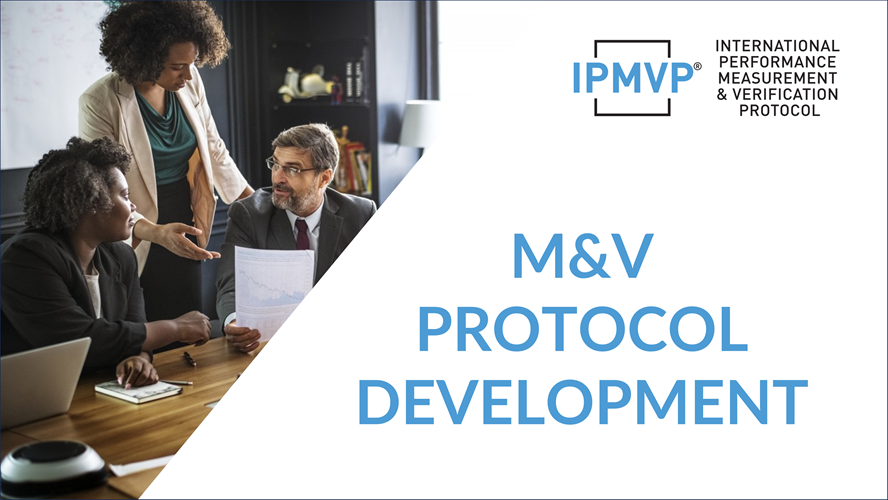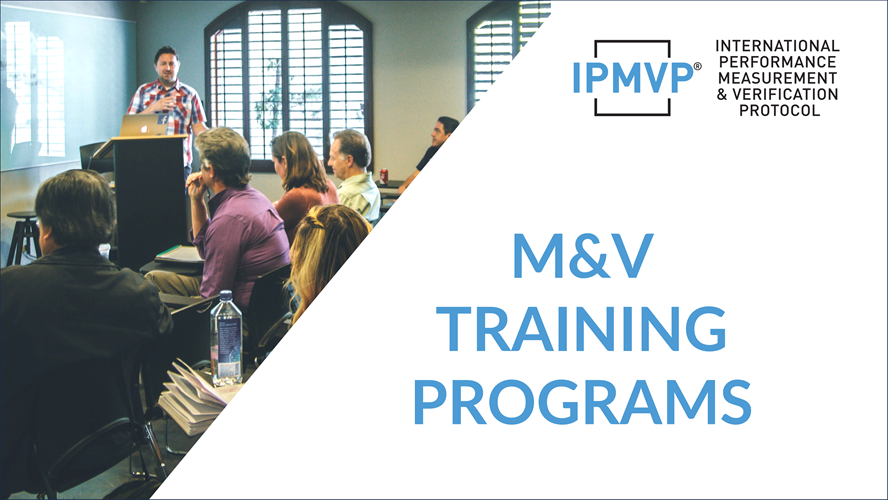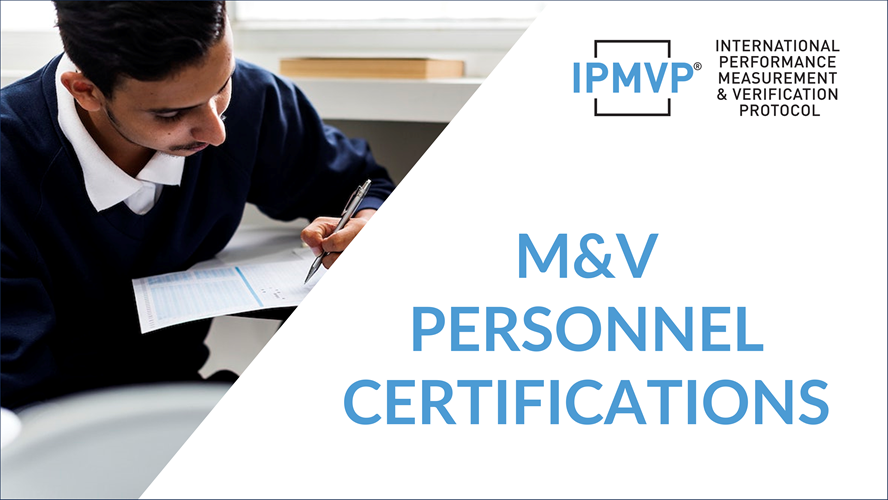Product & Services
This one-day training introduces the basics concepts of M&V and the IPMVP. It highlights the purposes of M&V, the range of possible M&V methods, and the need for specific M&V design for each project. The program is designed for management, financial, regulatory and technical professionals who want a basic understanding of the role of M&V in supporting energy efficiency retrofits and investments.
EVO offers a full range of M&V related training programs ranging from a one-hour introductory workshop to several days advanced training. Our programs are delivered by highly skilled instructors. EVO-approved instructors are M&V experts authorized by EVO´s Training Committee to provide trainees with M&V trainings. Instructors have a teaching background and experience in the field of M&V. They are approved by the Training Committee and must renew their instructor status periodically. Based on the degree of knowledge and expertise in the M&V field, EVO qualifies instructors into three different levels: L2, L3, and L4, each of them with various attributions.
L2 INSTRUCTOR (INTRODUCTORY) – can teach only introductory training (up to 1-day). L2 instructors have a teaching background and experience in the field of M&V. They have been approved by the Training Committee and must renew their status every three years.
L3 INSTRUCTOR (M&V FUNDAMENTALS) – can teach the M&V Fundamentals and IPMVP course. L3 instructors can also teach introductory L2 training. L3 instructors must meet all L2 instructor requirements, and additionally, they must have practical experience in M&V and preparation/implementation of M&V Plans. L3 instructors must go through a mentoring process before being formally approved by the Training Committee. They must renew their status every three years.
L4 INSTRUCTOR (ADVANCED) – can teach advanced M&V training. L4 instructors can also teach introductory classes as well as the M&V Fundamentals and IPMVP course. L4 instructors must meet all L3 instructor requirements. Additionally, they must show an in-depth knowledge in one of the M&V topics. Before becoming an L4 instructor, the candidate must have delivered several times the M&V Fundamentals and IPMVP as an L3 instructor. L4 instructors must go through a stringent evaluation process consisting of preparing a technical paper on a specific M&V topic and deliver a master class before being formally approved by the Training Committee. All L4 instructors must renew their status every three years. Some L4 instructors can be qualified as a mentor. Mentors can evaluate candidate-instructors to become EVO-approved L3 instructors.
This training prepares students for a four hour certification exam taken at the end of the two and one-half day training period. The course covers introductory topics and tackles subjects such as preparing a M&V Plan and the basic methods of Retrofit Isolation, Whole Facility, and Calibrated Simulation examples.
The training is geared toward the needs of a variety of professionals working mostly in an M&V advisory role including performance contractors; energy auditors wanting to expand their expertise into verification roles; large energy users using performance contracting; large energy users interested in getting a better understanding of their energy budgets and being able to explain significant variations and fluctuations in energy use; and energy efficiency program designers, policy makers and managers working for government or utilities.
Agenda: Two and a Half Day Workshop
Trainees Pre-course Work. We recommend trainees go through the following information before attending this course.
- Read IPMVP Core Concepts 2016 version.
- Read Uncertainty Assessment for IPMVP 2018 (updated in 2019)
- Read Measurement & Verification - Issues and Examples 2019 version
- Read chapter 4 of
Metering Best Practices: A Guide to Achieving Utility Resource Efficiency
- Have previous knowledge on basic statistics. If you are taking the course, please go through this survey. If you cannot answer the questions straight away and get one or more wrong answers to these 4 questions, or if you are not comfortable with the content of the questions, then we recommend you take the Introduction to Statistics for M&V (ISM&V) on line training module. This short module provides a refresher in the basic statistical concepts that underpin the statistics training in the course. At the moment, the ISMV is available only in English. If you are taking the course in English, the ISM&V course is automatically included in your course fee. See below on how to obtain your access code.
IMPORTANT NOTIFICATION
If you are taking the M&V Fundamental and IPMVP course with a provider other than FIRE and AFNOR, the Introduction to Statistics for M&V (ISM&V) is automatically included in your course fee. Your Training Provider will give you the password and the access link for the online course when you pay for your M&V Fundamentals and IPMVP training.
If you wish to take the ISM&V in English OR if you are not taking the M&V Fundamentals and IPMVP course and you would just like to refresh your knowledge in statistics, please go to the EVO Thematic Courses and select the ISM&V.
| Day 1 | |
|
8:30 |
Course Introduction. Registration and welcome coffee |
|
9:00 |
MODULE 1 Reasons for M&V and getting to know each other
|
|
|
MODULE 2 Key Concepts
|
| (Coffee break) | |
|
11:00 |
MODULE 3 Short Examples A short overview of 4 cases
|
| 12:30 - 13:30 | Lunch break (time is approximate) |
|
13:30 - 16:30 |
MODULE 4 Developing an M&V Plan
|
|
16:30 |
An introduction to an exemplary M&V Plan: the School A |
|
17:00 |
End of first day |
|
Day 2 |
|
| 08:30 |
A 10' quick review of the important items of the first day |
|
08:40 |
MODULE 5 Critical Issues in M&V
|
| (Coffee break) | |
|
11:00 |
MODULE 6 M&V Calculations Basics of statistical analysis: regression, sampling, distributions, error management
(Lunch break) (Coffee break) |
|
16:30 |
MODULE 7 Retrofit Isolation Option B |
| 17:00 |
End of Second day |
|
Day 3 |
|
|
08:30 |
A 10' quick review of the important items of the second day and specially Option B Module 7 |
|
08:40 |
MODULE 7, 8 and 9 Steps in Implementing IPMVP Options, with Examples
|
| (Coffee break) | |
|
11:00 |
MODULE 10 Other M&V Issues
|
|
11:40 |
MODULE 11 Summary  Which IPMVP option is best suited to my project? Which IPMVP option is best suited to my project? |
|
12:00 |
QUIZ & additional questions |
|
12:30 |
End of the PMVA course |
|
13:30 |
Exam preparation: proctor reading instructions, verification that all examinee have a stand-alone calculator in conformance with the exam rules, distribution of pencils and scantrons. |
|
13:45 |
Exam time: 4 hours |
Librería IPMVP de Documentos Públicos
|
La librería IPMVP de documentos consiste en varios volúmenes del Protocolo Internacional de Medida y Verificación (IPMVP). El IPMVP muestra una introducción de las mejores técnicas disponibles, practicadas hoy en día, sobre la verificación de los resultados en eficiencia energética, eficiencia de agua, y proyectos de energías renovables en instalaciones industriales y comerciales. También los operarios de instalaciones lo pueden utilizar para valorar y mejorar el rendimiento de la instalación. Las Medidas de Conservación de la Energía (ECMs) tratadas en el protocolo incluyen medidas de ahorro de combustible, medidas de eficiencia sobre agua, reducción de carga y energía en la instalación por medio de la mejora de equipos, y/o la modificación de los procedimientos de operación. |
|
En algunos documentos está recomendado el uso el IPMVP en un programa o está referenciado como buenas prácticas en otras publicaciones Aquí puedes encontrar estas citas.
La versión española de la página web y la traducción del IPMVP Volumen I, 2007 al español ha sido posible gracias a la especial colaboración de Union Fenosa, España.
Actualidad
 Conceptos y Opciones para Determinar el Ahorro de Energía y Agua - Volumen I
Conceptos y Opciones para Determinar el Ahorro de Energía y Agua - Volumen I
El Volumen I define la terminología básica utilizada en el campo de M&V. Define los procedimientos generales para conseguir de forma fiable y rentable la determinación de los ahorros. La verificación real de los ahorros se realiza con un Plan de M&V específico para cada proyecto. Este volumen describe las aplicaciones genéricas de medida y verificación en proyectos de mejora de eficiencia energética o de agua en edificios o plantas industriales.
![]() Inglés - EVO 10000 - 1:2010
Inglés - EVO 10000 - 1:2010
![]() Bulgarian - EVO 10000 - 1:2010 (BG)
Bulgarian - EVO 10000 - 1:2010 (BG) ![]() Español - EVO 10000 - 1:2010 (ES)
Español - EVO 10000 - 1:2010 (ES)
 Conceptos y Opciones para Determinar el Ahorro de Energía y Agua - Volumen I, 2009
Conceptos y Opciones para Determinar el Ahorro de Energía y Agua - Volumen I, 2009
![]() Inglés - EVO 10000 - 1:2009
Inglés - EVO 10000 - 1:2009 ![]() Francés - EVO 10000 - 1:2009 (FR)
Francés - EVO 10000 - 1:2009 (FR) ![]() Español - EVO 10000 - 1:2009 (ES)
Español - EVO 10000 - 1:2009 (ES)
![]() Portugués - EVO 10000 - 1:2009 (PT)
Portugués - EVO 10000 - 1:2009 (PT)
![]() Catalan - EVO 10000 - 1:2009 (CAT)
Catalan - EVO 10000 - 1:2009 (CAT)
 Conceptos y Opciones para Determinar el Ahorro de Energía y Agua - Volumen I, 2007
Conceptos y Opciones para Determinar el Ahorro de Energía y Agua - Volumen I, 2007
![]() Inglés - EVO 10000 - 1:2007
Inglés - EVO 10000 - 1:2007
![]() Francés - EVO 10000 - 1:2007 (FR)
Francés - EVO 10000 - 1:2007 (FR)
![]() Polaco - EVO 10000 - 1:2007 (PL)
Polaco - EVO 10000 - 1:2007 (PL) ![]() Portugués - EVO 10000 - 1:2007 (PT)- borrador
Portugués - EVO 10000 - 1:2007 (PT)- borrador ![]() Chino - EVO 10000 - 1:2007 (CN)
Chino - EVO 10000 - 1:2007 (CN) ![]() Español - EVO 10000 - 1:2007 (ES)
Español - EVO 10000 - 1:2007 (ES) ![]() Brasileño - EVO 10000 - 1:2007 (BR)
Brasileño - EVO 10000 - 1:2007 (BR)
 Conceptos y Prácticas para la Mejora de la Calidad Ambiental Interior - Volumen II, 2001
Conceptos y Prácticas para la Mejora de la Calidad Ambiental Interior - Volumen II, 2001
El Volumen II revisa las cuestiones relacionados con la calidad ambiental interior que puede ser influenciada por un proyecto de eficiencia energética. Se centra en la medición y diseño de los proyectos y las prácticas de ejecución asociadas con el mantenimiento de condiciones aceptables de interior en virtud de un proyecto de eficiencia energética. Asesora sobre los métodos de medida de las condiciones ambientales para verificar que la calidad de las condiciones se mantienen bajo control.
 Aplicaciones - Volumen III
Aplicaciones - Volumen III
El Volumen III facilita una orientación de las aplicaciones – especificaciones de M&V.
I - Conceptos y Opciones para Determinar el Ahorro de Energía en Nuevas Construcciones
II - Conceptos y Prácticas para Determinar el Ahorro de Energía en Aplicaciones Técnicas de Energías Renovable, 2003
Archivos
 Aplicaciones - Volumen III
Aplicaciones - Volumen III
I - Conceptos y Opciones para Determinar el Ahorro de Energía y Agua en Nuevas Construcciones, 2003
 Conceptos y Opciones para Determinar el Ahorro de Energía y Agua - Volumen I, 2007
Conceptos y Opciones para Determinar el Ahorro de Energía y Agua - Volumen I, 2007
 Conceptos y Opciones para Determinar el Ahorro de Energía y Agua - Volumen I, 2002
Conceptos y Opciones para Determinar el Ahorro de Energía y Agua - Volumen I, 2002
![]() Inglés
Inglés ![]() Chino
Chino![]() Francés
Francés![]() Italiano
Italiano ![]() Portugués
Portugués
 Protocolo Internacional de Medida y Verificación - 1997
Protocolo Internacional de Medida y Verificación - 1997
![]() Inglés
Inglés ![]() Checo
Checo ![]() Japonés
Japonés ![]() Rumano
Rumano ![]() Español
Español ![]() Ucraniano
Ucraniano
 NEMVP - 1996
NEMVP - 1996
|
8:30 |
Course Introduction. Registration and welcome coffee |
|
9:00 |
MODULE 1 Reasons for M&V and getting to know each other
|
|
|
MODULE 2 Key Concepts
|
| (Coffee break) | |
|
11:00 |
MODULE 3 Short Examples A short overview of 4 cases
|
| 12:30 - 13:30 | Lunch break (time is approximate) |
|
13:30 - 16:30 |
MODULE 4 Developing an M&V Plan
|
|
16:30 |
An introduction to an exemplary M&V Plan: the School A |
|
17:00 |
End of course |







